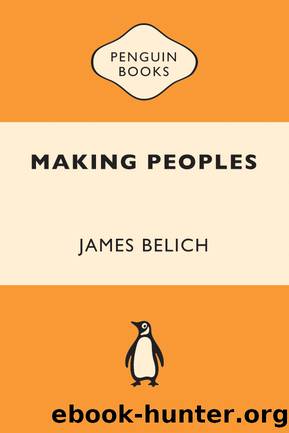Making Peoples by Belich James

Author:Belich, James
Language: eng
Format: epub
ISBN: 9781742288222
Publisher: Penguin New Zealand
Published: 2013-10-25T00:00:00+00:00
There was a degree of biological and cultural assimilation in the South Island, but this had advantages as well as disadvantages. Owing to the establishment of prolific mixed-race families in 1820â50, coupled with what was apparently a persistent preference for Pakeha husbands among Ngai Tahu women, the majority of Ngai Tahu were of mixed race by 1878, and the last âpurebloodâ was said to have died in 1910.25 As in the country as a whole, the European genes of Maori differed somewhat from those of Pakeha. Ironically, the Maori of Otago and Southland may have been more English than the local Pakeha, whose leading ethnic group was Scots. The preference for Pakeha husbands may reflect an acceptance of European perceptions of racial status, but it seems more likely to stem from the perceived material advantages of such spouses, and perhaps to a folk belief that European genes helped immunise children against European disease â white husbands as the equivalent of a polio injection. Deliberate policy may also have been a factor â a persistent marriage-alliance strategy. In the 1900s, there was apparently some reversal of this policy, to preserve chiefly blood lines and cement land claims, which suggests group leaders still had the power to direct marriages.26
It seems that something of a split emerged between the descendants of the early Maori-Pakeha families and the main stream of Ngai Tahu, who were also increasingly of mixed blood.27 The early mixed families in the Deep South were patrilocal â living with Dadâs community â whereas those in the north were more often matrilocal. Wives and children are said to have adopted the husbandâs culture, whereas among Old New Zealand Pakeha Maori families generally it was usually the other way around. But the European culture of the old sealing, trading and farming settlements that survived on the shores of Foveaux Strait until the 1860s was not that of mass-settlement Otago and Southland. There is some evidence that, in the late nineteenth century, their European-Maori descendants were linked to, yet separate from, both mainstream Pakeha and mainstream Ngai Tahu. They saw themselves, and were seen as, a little different from either; they were even more landless than Ngai Tahu proper; and they were more prone to urbanising and the acquisition of European skills. Many âlived as Europeansâ according to the census definition, and were excluded from Maori population statistics. Including them would flatten the graph of Ngai Tahu population decline.
This group is the closest New Zealand came to developing a bi-culture like the Métis of Canada or the Griqua of South Africa. That it came no closer is evidence of the persistent strength of Maori identity. Some southern âMétisâ simply disappeared into the Pakeha population in the twentieth century. But the heavily swamped Ngai Tahu found some of their more Europeanised kin a useful mediator group, or a potentially useful fifth column in Pakeha society, ready to return to their Maori allegiance when the time was ripe. This supplemented the strategy of persistent marriage alliance.
Download
This site does not store any files on its server. We only index and link to content provided by other sites. Please contact the content providers to delete copyright contents if any and email us, we'll remove relevant links or contents immediately.
| Africa | Americas |
| Arctic & Antarctica | Asia |
| Australia & Oceania | Europe |
| Middle East | Russia |
| United States | World |
| Ancient Civilizations | Military |
| Historical Study & Educational Resources |
Machine Learning at Scale with H2O by Gregory Keys | David Whiting(3648)
Never by Ken Follett(3537)
Fairy Tale by Stephen King(2958)
The Man Who Died Twice by Richard Osman(2812)
Oathbringer (The Stormlight Archive, Book 3) by Brandon Sanderson(2645)
Will by Will Smith(2584)
Rationality by Steven Pinker(2153)
The Dark Hours by Michael Connelly(2082)
The Dawn of Everything: A New History of Humanity by David Graeber & David Wengrow(2019)
Friends, Lovers, and the Big Terrible Thing by Matthew Perry(2008)
Can't Hurt Me: Master Your Mind and Defy the Odds - Clean Edition by David Goggins(2007)
Principles for Dealing With the Changing World Order: Why Nations Succeed and Fail by Ray Dalio(1902)
HBR's 10 Must Reads 2022 by Harvard Business Review(1702)
A Short History of War by Jeremy Black(1676)
Go Tell the Bees That I Am Gone by Diana Gabaldon(1601)
515945210 by Unknown(1524)
443319537 by Unknown(1399)
Kingdom of Ash by Maas Sarah J(1393)
A Game of Thrones (The Illustrated Edition) by George R. R. Martin(1374)
